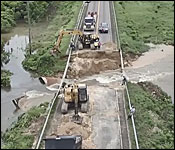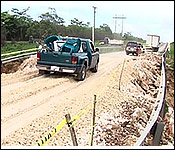
 When we left you last night, the Cayo District was an island, cut off from Central Belize after the approach to the Beaver Dam Bridge was washed out, and cut off form the south due to multiple flooding events on the Hummingbird.
When we left you last night, the Cayo District was an island, cut off from Central Belize after the approach to the Beaver Dam Bridge was washed out, and cut off form the south due to multiple flooding events on the Hummingbird.
Well, much to the relief of dozens of commuters and busloads of westbound travelers, the Western Highway was reopened at about 10:00 last night.
This afternoon we caught up with Ministry of Works engineer Lennox Bradley and Zone Engineer Irving Thimbrel for a recap of what they're calling an extreme event that crippled one of Belize's major roadways.
This was the scene today as rush hour traffic moved across the one-lane makeshift crossing leading to the Beaver Dam Bridge. It's an uneasy balance, rock and rushing waters, and it's being maintained by constant vigilance with the hope that it will hold for as long as it's needed. This afternoon we made the crossing to travel to Belmopan where the Ministry of Works chief engineer told us how we got here:
Lennox Bradley, Chief Engineer, MOW
"The weather that we have been experiencing over the past couple days, particularly that day, we got at least 12 to 14 hours of heavy rain. The amount of rainfall that fell during that short time period really affected several areas of our national transportation system particularly the George Price Highway at mile 38 ½."
"We had traffic interrupted as well because a small section of the George Price Highway was washed away. Again due to the flooding the volume of water that traversed that section there."
Also on hand yesterday was central Zone engineer Irving Thimbrel, the man responsible for road maintenance throughout the Cayo district. And his afternoon he didn't hide the fact that he was fazed by yesterday's events.
 Irving Thimbrel, Senior Executive Engineer, Central Zone Engineer, MOW
Irving Thimbrel, Senior Executive Engineer, Central Zone Engineer, MOW
"What we saw out there yesterday was an extreme event, so we're going to look at it and when the decision is made its either going to be a bridge which I believe it's going to be after the numbers are crunched, or more culverts with greater capacity. Depends on what the study show."
"If you look down the stream from where we were you will see that there is a bridge structure there. It was much lower than the bridge that was there the existing one. What was washed away was some large culverts and we believe that before my time at the Ministry of Works. It was under Crown agents, they believe at what they had done and we know because it worked for quite some time, we have never seen what happened yesterday happening before at least not in my life time we have not seen it and so it functions and so what has to happen now, we have to look at the real situation, there is a next that people have to understand - when looking at these events, how often do they occur? What did that represent yesterday, a one in twenty five year flood, one in fifty year flood, a one in a hundred year flood?"
"It's an elaborate French drain, what a French drain is, you put a trench or something and you full it up with rocks and then leaving the spaces where that exist between the rocks because they don't bond into a solid mass that allows for the passage of water but the bond between the adjacent rocks is able to withstand whatever lateral force is coming from the water that would be created by any kind of flooding event. So it would allow for the water to pass through but also be structurally sound to allow for the vehicles to pass over it."
And while we have this temporary solution, a permanent one is sorely needed but it will have to be a solution equipped to battle all the realities of the day, from climate change to the demands of modern traffic, and even the ongoing clearing of the land.
 Lennox Bradley, Chief Engineer, MOW
Lennox Bradley, Chief Engineer, MOW
"We are noticing now that our national transportation system is under a lot of stress partly because of climate change and partly because of developmental issues. With time we have investments made for the purpose of clearing land for agricultural purposes and the clearing of land will certainly affect the runoff that we get on our drainage system. On the George Price Highway, that road is practically 40 years old and we have not done much changes to the drainage systems. Only when they collapse we replace the culverts but we have not made any substantial changes in terms of increasing the hydraulic capacity to try and make that section of the road more climate resilient."
"We have started looking at that section and seeing over the past few years what sort of challenges we have. That's a very important artery for the government and people of Belize, it's the main evacuation route when we have a disaster, that's the route they use when they use when bringing evacuees to the Cayo District, so it's very important. Upgrading that section of the road to make it more climate resilience and to accommodate the sort of hydraulic challenges that we have there it's not cheap. It's something that we have to plan for and thereafter secure funding for it. As I said we know what are the challenges out there. What needs to be done is to design that road and secure funding for the final upgrade but that would have to be at the very earliest the medium term."
According to Chief Engineer Bradley, a timeline for that permanent solution is impossible to pin down as it will depend largely on securing funding for the necessary upgrades.



